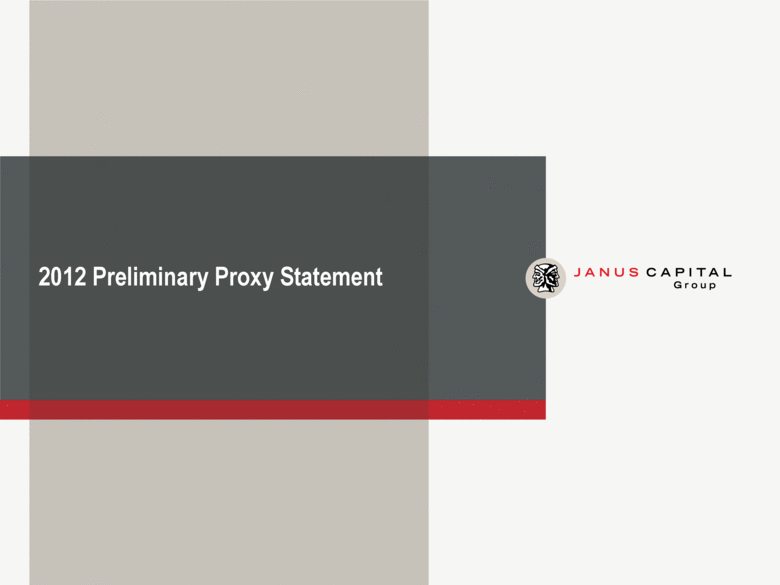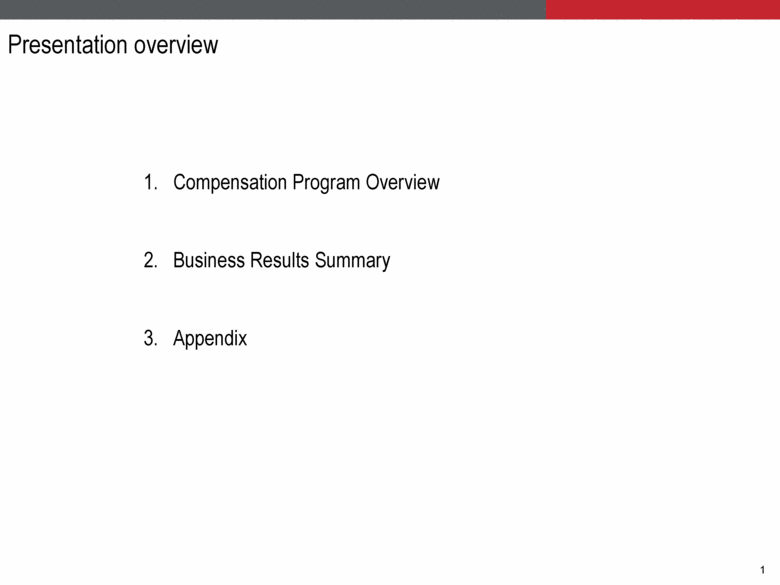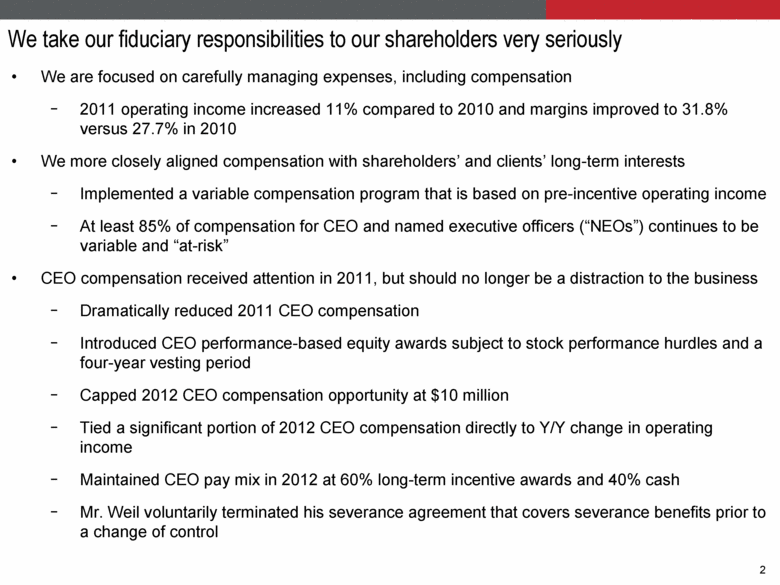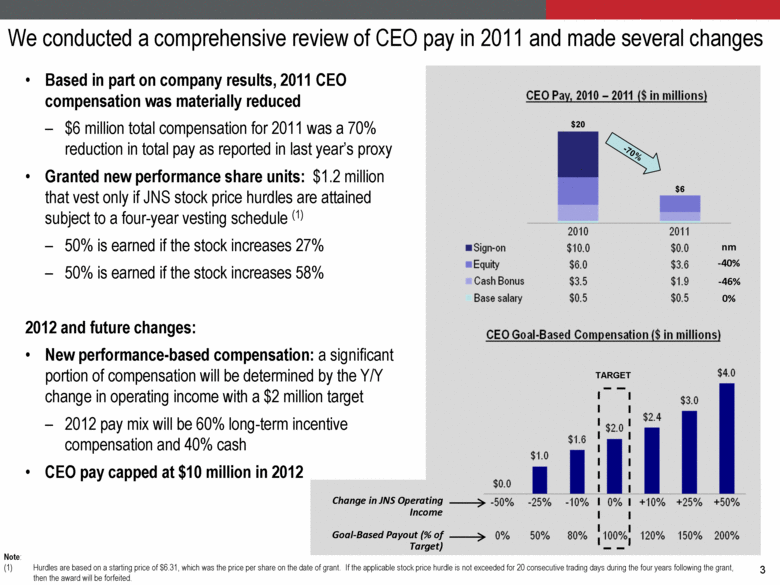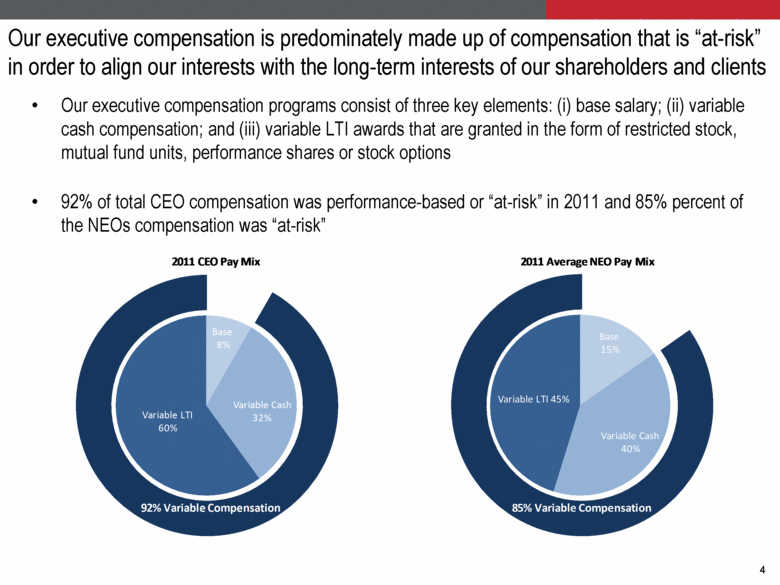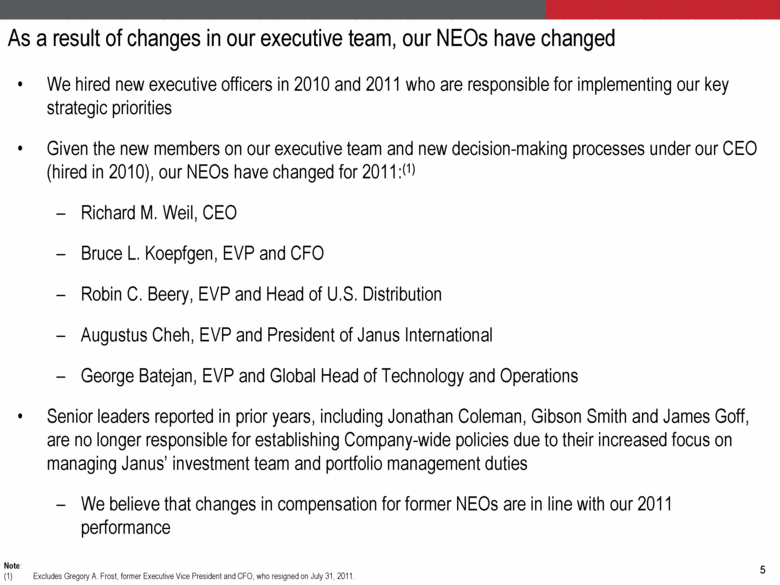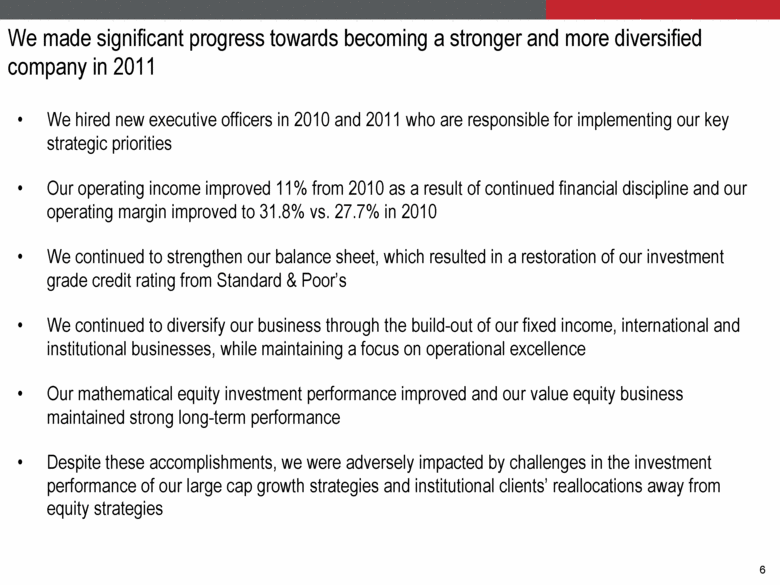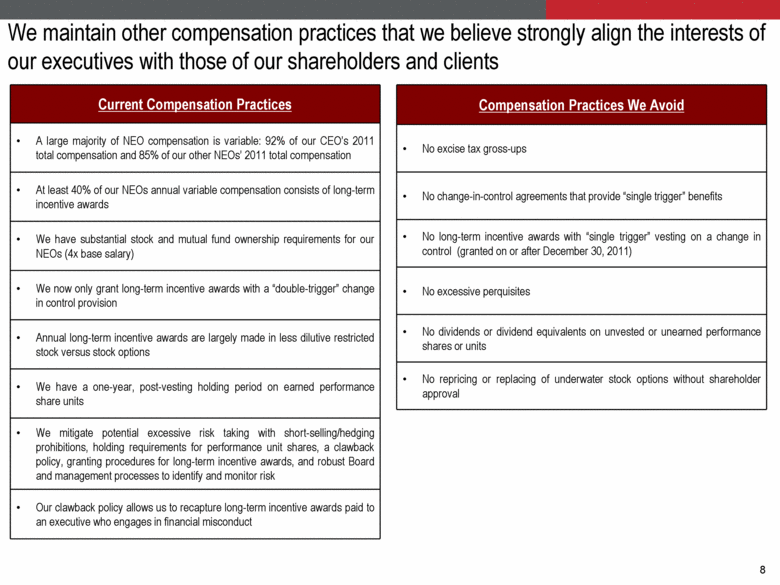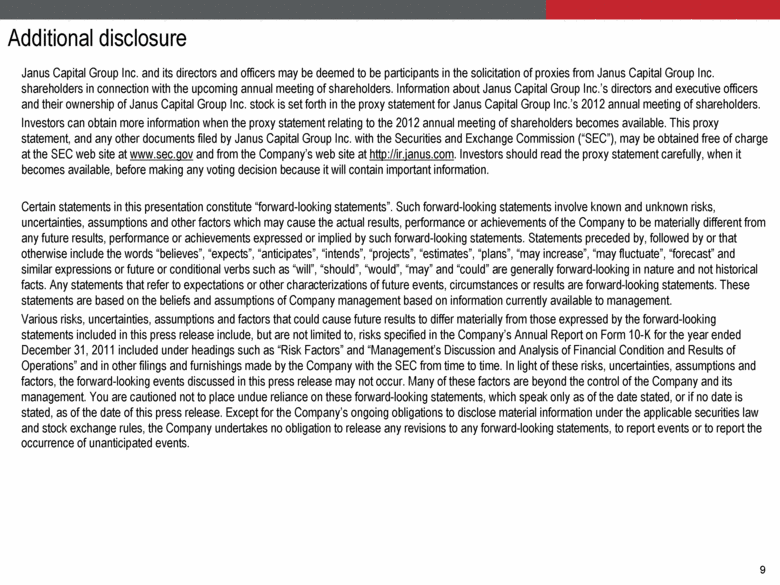Attached files
| file | filename |
|---|---|
| 8-K - 8-K - JANUS CAPITAL GROUP INC | a12-1515_58k.htm |
Exhibit 99.1
|
|
2012 Preliminary Proxy Statement |
|
|
Compensation Program Overview Business Results Summary Appendix Presentation overview |
|
|
We are focused on carefully managing expenses, including compensation 2011 operating income increased 11% compared to 2010 and margins improved to 31.8% versus 27.7% in 2010 We more closely aligned compensation with shareholders’ and clients’ long-term interests Implemented a variable compensation program that is based on pre-incentive operating income At least 85% of compensation for CEO and named executive officers (“NEOs”) continues to be variable and “at-risk” CEO compensation received attention in 2011, but should no longer be a distraction to the business Dramatically reduced 2011 CEO compensation Introduced CEO performance-based equity awards subject to stock performance hurdles and a four-year vesting period Capped 2012 CEO compensation opportunity at $10 million Tied a significant portion of 2012 CEO compensation directly to Y/Y change in operating income Maintained CEO pay mix in 2012 at 60% long-term incentive awards and 40% cash Mr. Weil voluntarily terminated his severance agreement that covers severance benefits prior to a change of control We take our fiduciary responsibilities to our shareholders very seriously |
|
|
We conducted a comprehensive review of CEO pay in 2011 and made several changes Based in part on company results, 2011 CEO compensation was materially reduced $6 million total compensation for 2011 was a 70% reduction in total pay as reported in last year’s proxy Granted new performance share units: $1.2 million that vest only if JNS stock price hurdles are attained subject to a four-year vesting schedule (1) 50% is earned if the stock increases 27% 50% is earned if the stock increases 58% 2012 and future changes: New performance-based compensation: a significant portion of compensation will be determined by the Y/Y change in operating income with a $2 million target 2012 pay mix will be 60% long-term incentive compensation and 40% cash CEO pay capped at $10 million in 2012 Change in JNS Operating Income Goal-Based Payout (% of Target) Note: Hurdles are based on a starting price of $6.31, which was the price per share on the date of grant. If the applicable stock price hurdle is not exceeded for 20 consecutive trading days during the four years following the grant, then the award will be forfeited. $20 $6 -70% -46% 0% TARGET CEO Pay, 2010 – 2011 ($ in millions) |
|
|
Our executive compensation is predominately made up of compensation that is “at-risk” in order to align our interests with the long-term interests of our shareholders and clients Our executive compensation programs consist of three key elements: (i) base salary; (ii) variable cash compensation; and (iii) variable LTI awards that are granted in the form of restricted stock, mutual fund units, performance shares or stock options 92% of total CEO compensation was performance-based or “at-risk” in 2011 and 85% percent of the NEOs compensation was “at-risk” Base 8% Variable Cash 32% Variable LTI 60% 92% Variable Compensation 2011 CEO Pay Mix 2011 Average NEO Pay Mix |
|
|
As a result of changes in our executive team, our NEOs have changed We hired new executive officers in 2010 and 2011 who are responsible for implementing our key strategic priorities Given the new members on our executive team and new decision-making processes under our CEO (hired in 2010), our NEOs have changed for 2011:(1) Richard M. Weil, CEO Bruce L. Koepfgen, EVP and CFO Robin C. Beery, EVP and Head of U.S. Distribution Augustus Cheh, EVP and President of Janus International George Batejan, EVP and Global Head of Technology and Operations Senior leaders reported in prior years, including Jonathan Coleman, Gibson Smith and James Goff, are no longer responsible for establishing Company-wide policies due to their increased focus on managing Janus’ investment team and portfolio management duties We believe that changes in compensation for former NEOs are in line with our 2011 performance Note: Excludes Gregory A. Frost, former Executive Vice President and CFO, who resigned on July 31, 2011. |
|
|
We made significant progress towards becoming a stronger and more diversified company in 2011 We hired new executive officers in 2010 and 2011 who are responsible for implementing our key strategic priorities Our operating income improved 11% from 2010 as a result of continued financial discipline and our operating margin improved to 31.8% vs. 27.7% in 2010 We continued to strengthen our balance sheet, which resulted in a restoration of our investment grade credit rating from Standard & Poor’s We continued to diversify our business through the build-out of our fixed income, international and institutional businesses, while maintaining a focus on operational excellence Our mathematical equity investment performance improved and our value equity business maintained strong long-term performance Despite these accomplishments, we were adversely impacted by challenges in the investment performance of our large cap growth strategies and institutional clients’ reallocations away from equity strategies |
|
|
Appendix |
|
|
We maintain other compensation practices that we believe strongly align the interests of our executives with those of our shareholders and clients Current Compensation Practices A large majority of NEO compensation is variable: 92% of our CEO’s 2011 total compensation and 85% of our other NEOs’ 2011 total compensation At least 40% of our NEOs annual variable compensation consists of long-term incentive awards We have substantial stock and mutual fund ownership requirements for our NEOs (4x base salary) We now only grant long-term incentive awards with a “double-trigger” change in control provision Annual long-term incentive awards are largely made in less dilutive restricted stock versus stock options We have a one-year, post-vesting holding period on earned performance share units We mitigate potential excessive risk taking with short-selling/hedging prohibitions, holding requirements for performance unit shares, a clawback policy, granting procedures for long-term incentive awards, and robust Board and management processes to identify and monitor risk Our clawback policy allows us to recapture long-term incentive awards paid to an executive who engages in financial misconduct Compensation Practices We Avoid No excise tax gross-ups No change-in-control agreements that provide “single trigger” benefits No long-term incentive awards with “single trigger” vesting on a change in control (granted on or after December 30, 2011) No excessive perquisites No dividends or dividend equivalents on unvested or unearned performance shares or units No repricing or replacing of underwater stock options without shareholder approval |
|
|
Additional disclosure Janus Capital Group Inc. and its directors and officers may be deemed to be participants in the solicitation of proxies from Janus Capital Group Inc. shareholders in connection with the upcoming annual meeting of shareholders. Information about Janus Capital Group Inc.’s directors and executive officers and their ownership of Janus Capital Group Inc. stock is set forth in the proxy statement for Janus Capital Group Inc.’s 2012 annual meeting of shareholders. Investors can obtain more information when the proxy statement relating to the 2012 annual meeting of shareholders becomes available. This proxy statement, and any other documents filed by Janus Capital Group Inc. with the Securities and Exchange Commission (“SEC”), may be obtained free of charge at the SEC web site at www.sec.gov and from the Company’s web site at http://ir.janus.com. Investors should read the proxy statement carefully, when it becomes available, before making any voting decision because it will contain important information. Certain statements in this presentation constitute “forward-looking statements”. Such forward-looking statements involve known and unknown risks, uncertainties, assumptions and other factors which may cause the actual results, performance or achievements of the Company to be materially different from any future results, performance or achievements expressed or implied by such forward-looking statements. Statements preceded by, followed by or that otherwise include the words “believes”, “expects”, “anticipates”, “intends”, “projects”, “estimates”, “plans”, “may increase”, “may fluctuate”, “forecast” and similar expressions or future or conditional verbs such as “will”, “should”, “would”, “may” and “could” are generally forward-looking in nature and not historical facts. Any statements that refer to expectations or other characterizations of future events, circumstances or results are forward-looking statements. These statements are based on the beliefs and assumptions of Company management based on information currently available to management. Various risks, uncertainties, assumptions and factors that could cause future results to differ materially from those expressed by the forward-looking statements included in this press release include, but are not limited to, risks specified in the Company’s Annual Report on Form 10-K for the year ended December 31, 2011 included under headings such as “Risk Factors” and “Management’s Discussion and Analysis of Financial Condition and Results of Operations” and in other filings and furnishings made by the Company with the SEC from time to time. In light of these risks, uncertainties, assumptions and factors, the forward-looking events discussed in this press release may not occur. Many of these factors are beyond the control of the Company and its management. You are cautioned not to place undue reliance on these forward-looking statements, which speak only as of the date stated, or if no date is stated, as of the date of this press release. Except for the Company’s ongoing obligations to disclose material information under the applicable securities law and stock exchange rules, the Company undertakes no obligation to release any revisions to any forward-looking statements, to report events or to report the occurrence of unanticipated events. |

